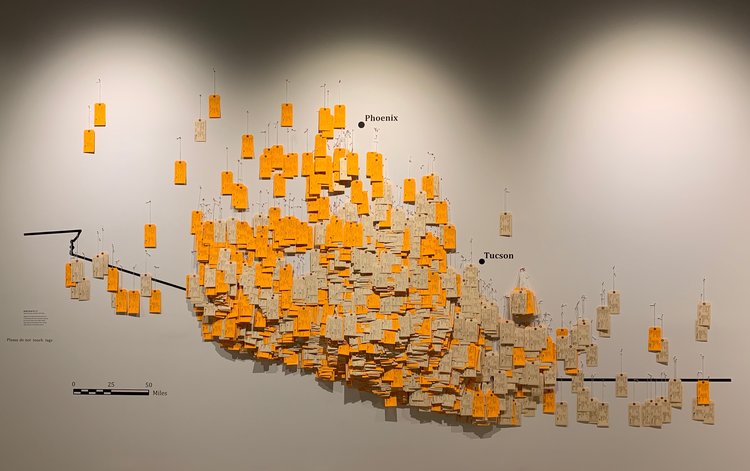Exhibit highlights deaths of undocumented border crossers
Hostile Terrain highlights 3,200+ who have died as result of “Prevention Through Deterrence” policy

Binghamton University is partnering with Roberson Museum and Science Center to host two exhibitions which memorialize and highlight the stories of migrants. Both exhibitions open at 6 p.m. Friday, Oct. 1, at the Roberson Museum and Science Center, 30 Front. St., Binghamton.
Binghamton University anthropologists David Mixter and Ana Sanchez Bachman will introduce “Hostile Terrain 94”; and photographer Manuel Gil and Binghamton University ethnographer Oscar Gil-Garcia will discuss their ethnographic photography project “Legacies of Forced Migration.” Remarks will be offered at 6:30 p.m. by those involved.
“Hostile Terrain 94”
“Hostile Terrain 94” seeks to memorialize and bear witness to the humanitarian crisis at the U.S./Mexico Border that has claimed the lives of thousands of people since the 1990s. Since 1994, more than 3,200 people have died of dehydration, exposure and violence in the southern Arizona desert as a direct result of the US “Prevention Through Deterrence” (PTD) policy. PTD channels undocumented border crossers away from populated areas into the “hostile terrain” of a harsh and arid desert landscape.
HT94 was developed by the Undocumented Migration Project (UMP), a non-profit research-art-education-media collective directed by UCLA anthropologist Jason De León. The exhibit is being mounted simultaneously at over 150 national and global institutions. The interactive exhibit invites volunteers to write the names of deceased migrants, along with their age, sex, cause of death, condition of their body and location of their recovery, on color-coded toe tags. Yellow tags represent people whose remains have been identified, while orange tags symbolize nearly 1,000 unidentified individuals. These tags are then geolocated and pinned to a wall map of the desert showing the exact locations where remains were found. On the completed map, the mass of 3,200 colored tags graphically illustrates the severity of the crisis.
“Legacies of Forced Migrations”
“Legacies of Forced Migration” explores the complex lives of Indigenous Maya who fled Guatemala during the civil war (1960–1996) and settled in Mexico and the United States. Developed by the artist Manuel Gil and Binghamton University ethnographer Oscar Gil-Garcia, this exhibit juxtaposes photographs and ethnographic narratives to record the day-to-day activities of residents of La Gloria, the largest refugee settlement in Chiapas, Mexico, as they re-create community and make claims for national belonging. In contrast to dominant portrayals of refugees as vulnerable, Manuel’s photos depict confident and strong refugees who for more than thirty years remained stateless in Mexico. Collectively, Manuel’s portraits and Oscar’s ethnography elucidate the profound resilience of Indigenous Maya. Their work illustrates how despite the malign neglect by the Mexican and US states toward Indigenous Maya, they and their families persist.
Previous iterations of this project have been exhibited at Oxford University’s Refugee Studies in the UK under the title “Guatemalan Forced Migration” (2005-06), and at Cornell University (2018-19) and the American Civic Association, Binghamton, NY (2020) under the title “From Stateless to Citizens: Guatemalan Refugees in Mexico”. In 2017, CENTER organization selected their collaborative work on stateless refugees for a juried show titled Art & Oppression. Photographs from this project have been published in academic journals and several Latin American and US publications, including Plaza Pública, América sin Muros, Univision, The Conversation, and Latino USA, with a total circulation of over 40 million. Legacies of Forced Migration is the culmination of these projects and the working title of Oscar and Manuel’s forthcoming book. The Open Society Foundation selected Legacies of Forced Migration as semifinalist for the 2021 Soros Justice Fellowship.
For information on the Hostile Terrain project, visit the webpage.
For more information on the exhibitions, contact David Mixter at dmixter@binghamton.edu.

